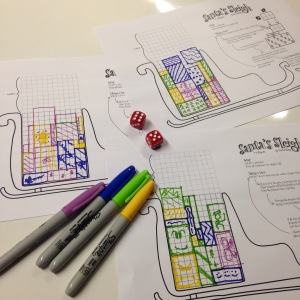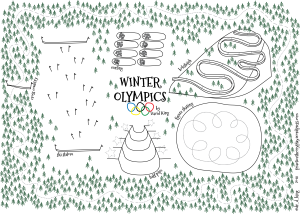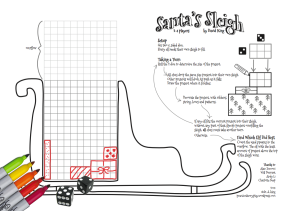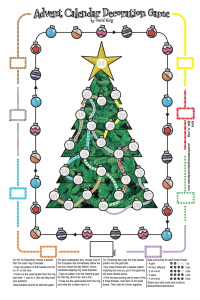Around two months ago I watched a ShutUpAndSitDown video talking about Welcome To, a roll and write game by Benoit Turpin. A couple of days later a friend brought Noch Mal by Inka Brand and Markus Brand to one of the monthly board game meet ups I attend. Then I wanted to jump on the bandwagon and have a go for myself.
My first attempt was Tube Lines, inspired by the London Underground network. It is a game that still needs a lot of work and isn’t really the subject of this post, but should be mentioned as it started me on the journey of designing games that could be played on a printed bit of A4, without having to cut anything out.
With Christmas and Winter coming, I was inspired to make three print and play games, one is a simple roll and write game, one is a solo advent calendar game and the final one is a quick drawing and racing game.
Santa’s Sleigh
The original concept for Santa’s Sleigh came together pretty quickly, roll two dice to make a box and put it into the sleigh. The first issue was to determine was the size of the sleigh, both the width and the height would affect how long the game took and how likely it would be to create situations where the boxes wouldn’t fit neatly creating gaps.
After some discussion with Alan at work, 11 across and 15 up seemed to work as a first guess which we tried out with some of our MA Games Design students.
The game was quick and relatively simple apart from the ending condition. The game only ends when all players simultaneously can’t place the current box into the sleigh. This rule was suppose to simulate the idea of a harsh working environment where if any one person is successful all employees are expected to be successful. This section of the rules took quite a few versions to get right.
Here is the change:
If any elf fits the current present into their sleigh without any part of that specific present overfilling the sleigh, all elves must take another turn.
became
If all elves simultaneously fail to fit their presents into the sleigh, so that all the presents go into the overflow this turn: Find which elf did best.
I did try making the rules more complex, by having specific types of wrapping paper that players would have to draw and then avoid touching similarly wrapped presents, but it really was not fun. There’s something to be said about a nice simple game, where you make boxes, put them in a sleigh and draw some nice wrapping paper on them. It really doesn’t need to be more complex than that.
One potential issue, is tied scores. As the game is simple, with simple rules, there is a risk of not having any divergent play between players. Most roll and writes will in some way encourage the players to take different actions. This can either be forced, they will have to use different dice at different times or unforced via complexity. This could be done with special moves activated when the player wants or by having a suitably large number of options, in both these cases there are so many reasonable options to select that the likelihood of all players picking the same one is slim.
I have simply decided to let the game be what it is, a light, simple Christmas game, who cares if the players get the same points sometimes.

You can find the sheet to print and play here.
Advent Calendar Decoration Game
Sometimes finding people to play with can be hard, sometimes finding the time to play a game can be hard. Here’s the solution to that: Advent Calendar Decoration Game, is a solo game where you make one move each day running up to Christmas. Then come Christmas day you can tally up your final score and compare it to other people across the World.
The game involves selecting decorations to add to your tree each day. Depending where you place the decorations and the sets they make along the ribbons will determine the score you get.
The core selection mechanic from this game is lifted from Patchwork by Uwe Rosenberg, in both you can select any of the next three items that are available. It’s a nice mechanic which simultaneously makes choices more manageable (pick one of three), but adds a lot of meaning (the choice you make determines the choices you can make in the future, and so on through the games). As the set of baubles is far smaller than the set of patches in Patchwork, the effect of this mechanic is reduced slightly, but easier to respond to.
I think the big breakthrough for the game was realising that the decorations could be on multiple ribbons allowing for a lot more complexity in the scoring results. Initially I had six ribbons each connecting to four different baubles. Adding the ribbons which intersect mean that there are certain positions on the tree that are more powerful, so the player has to be extra cautious around them.
Writing the rules clearly and concisely such that they could fit on the bottom of the page was a hassle. It was interesting learning that bauble and tinsel are not well known terms, especially for those where English is a second language. However, the context of the words seems to do enough to make it clear. It was the third section of the rules regarding bonus points which was the sticking point for a number of test reads. The last bauble the player has goes in the star on Christmas day, any ribbons that have the same type of bauble in them, score double points.
Initially, this bauble had to be part of the scoring set, i.e. if you got a pair, the pair would need to contain a bauble identical to the star bauble. Being more lax with the rule, made it a lot easier to describe. Now it doesn’t matter if it is part of the scoring set or not, just that it is on that ribbon. You will always have four baubles capable of double some scores, but there is interesting choices on where to use them, do you spread them our or cluster them together.
Is there a perfect score, almost certainly, but I’m not personally going to sit and work it out. I’d be interested to know how far ahead people plan their moves, or if they just play move-by-move each day.
You can find the sheet to print and play here.
Winter Olympics

Winter Olympics is a quick, light game about drawing neatly along lines in the fastest time. Each mistake you make will cost you some points risking you podium position.
I don’t know if I’d come to this idea if one of my now graduated students, Andrew, had not told me about a project of his, where they drew a racetrack with blackboard paint on a wall and challenged people to race the track with pieces of chalk. I’ve always liked the simplicity of this game, it’s very pure and understandable, but would lead to chaos when multiple people are playing on the same track.
For my variation on this idea I started off with the idea of a ski slalom game, and was initially intending to do multiple routes through a mountain, which the players would race to compete. I think there may be something still to this idea, as you could use different flags to denote the different routes giving the player a challenging multiple overlaid dot-to-dot style game.
But, instead of doing that, I considered adding the different sports from the Winter Olympics to add some variance.
- Cross Country Skiing involves avoiding trees and keeping to the route.
- Bobsleigh is similar but on a tighter smaller route.
- Halfpipe involves swooping up and down the halfpipe and drawing complex shapes at the top, representing tricks.
- Figure skating involves keeping very close to the line and being precise and smooth.
- Curling involves filling the dots, not the most accurate portrayal perhaps, but it does contrast nicely with the other events.
You can find the sheets to print and play here.









